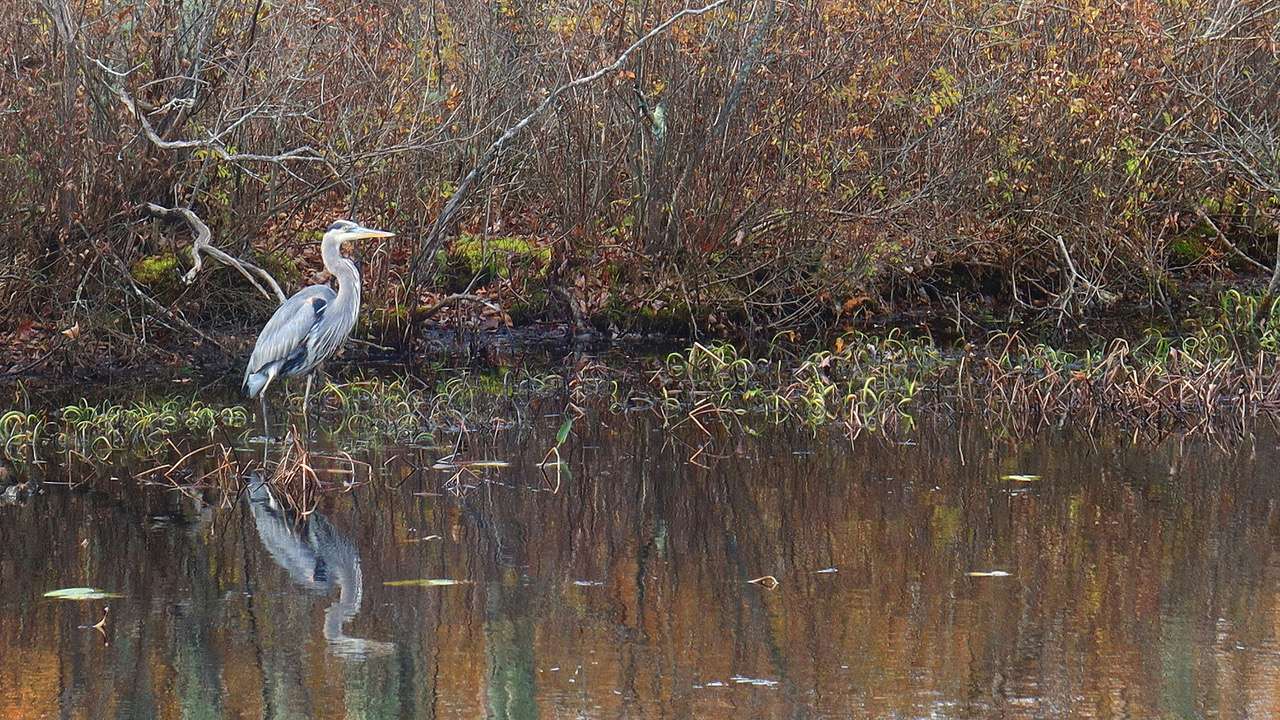Out In the Woods
- April 25th 2024
- Out in the Woods

A great blue heron forages along Number 2 Pond.
Photo: Terry Jellerson
Majestic Heron Can Often Be Seen at #1 Pond
By Kevin McKeon, Director, Mousam Way Land Trust
In an indirect way, we have a natural disaster to thank for many Sanford area residents’ first sighting of the majestic great blue heron. In mid-October 1947, more than 200 fires in southern and coastal Maine burned a quarter million acres, leveling nine towns, destroying more than 1,200 homes, killing 16 people, and leaving 2,500 people homeless. It was the worst natural disaster in Maine history; 1947 became known as “The Year Maine Burned.” Lack of water supplies to fight these fires was a factor in the heavy losses. Among various efforts mounted by Maine soil and water conservation districts to address future fires was the construction of rural farm ponds.
That led to the creation of a pond along Blanchard Road at the Sanford-Lebanon border. A dike was built to capture the waters of Branch Stream, and a vibrant wetland habitat was created. Wetland plants emerged. Birds and bats flocked to the insect nursery thus created, as did various amphibians—which in turn attracted otter, fox, marten, raccoon, egret, rail, hawk, and eagle. Some locals added fish to the pond. The flooded trees died but remained standing, as they often do. All this resulted in an ideal nesting spot for the great blue heron.
Herons nested there and drew birdwatchers for many years, until human activity nearby prompted these impressive creatures to relocate. Today, they can often be seen foraging at Number 1 and Number 2 ponds, along many other shoreland areas, and in Sanford. During a Sanford Mainers baseball game, keep an eye on the sky at dusk; they’re often seen flying from their foraging areas back to their rookery.
Typically, several pairs will breed in colonies called a heronry, a species-specific term for a heron rookery. Some herons will overwinter near salt marshes or stay well into winter wherever fresh water remains open.
Males returning in early March from their southern, ice-free habitat typically choose a nesting site high up in a tree and actively display to attract a female. They then gather sticks and give them to the female, who constructs a platform nest lined with small twigs, bark strips, and evergreen needles. Soon, they’re kept busy for about a month, tending to two to six pale blue eggs until they hatch. The parents bring the chicks fish, amphibians, reptiles, invertebrates, small mammals, and even other birds. After two months, the chicks can fly, or fledge, but the parents will keep feeding them for a couple more weeks.
Unfortunately, more than half of the great blue herons born in one year will die before they are a year old. Crows, raccoons, hawks, and eagles eat the eggs and chicks. Adult herons, however, are not commonly preyed on due to their large size. They will usually return to the same heronry, but not necessarily the same nest; some heronries serve for decades.
Standing 3 to 4 ½ feet tall with a 6-foot wingspan, but weighing only about 5 pounds, a great blue heron surprisingly doesn’t even make the top ten of Maine’s largest birds, coming in at 11th. The aggressive https://www.youtube.com/watch?v=rhKfpAanQKI&t=40s 26-pound mute swan is number one. These non-native birds with an 8-foot wingspan were introduced to “decorate” home ponds and have escaped into the wild.
Great blue herons typically live about 15 years, but 25-year-olds have been recorded. They’ll travel three miles to forage, standing silently along the shore, waiting for prey to come by, then stabbing their prey with a quick lunge of their bill. They will also stalk prey slowly and deliberately. When resting, they’ll fold their necks and sit in a sheltered spot or in a tree.






